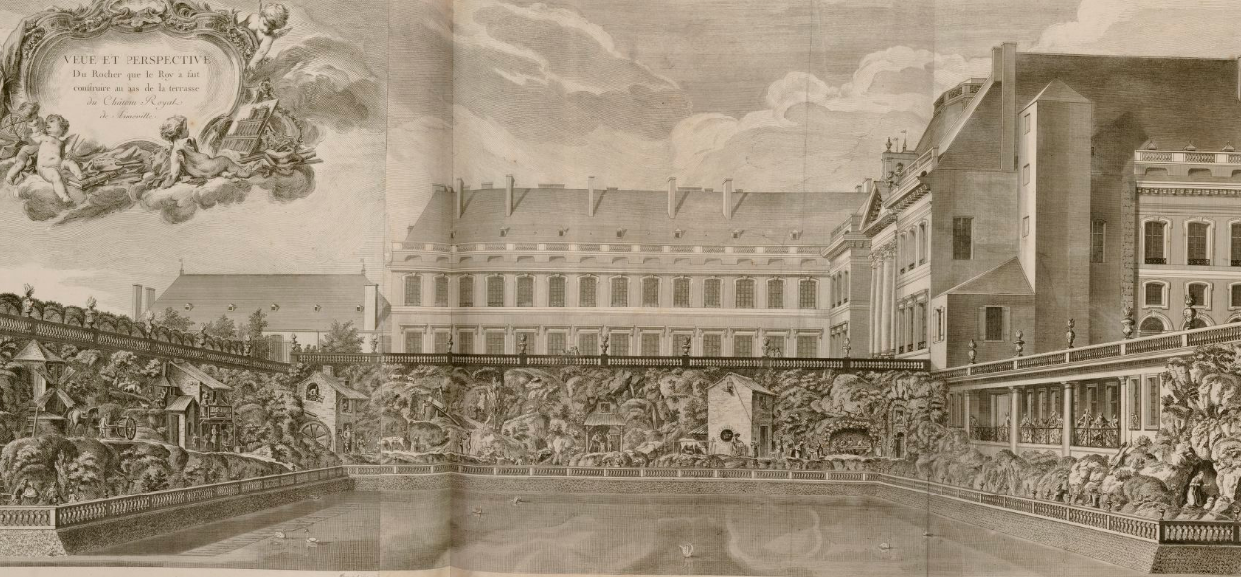No other work of art funded by Stanislas Leszczyński to his Lorraine palaces and gardens could be deemed equal to the Rocher, a spectacular mechanical theatre built by the king’s close collaborator and trusted architect, Emmanuel Héré, and Parisian clock-maker and engineer François Richard. The two–problably supervised by Leszczyński himself–created a remarkable and unique construction.
Built into the northern terrace of the Lunéville château, the Rocher measured 250 metres in length, and was positioned at the cruciform end of the canal created by closing the flow of the nearby river Vezouse with a lock: the water from the canal propelled the 88 (originally 86) automatic life-size sculptures of people and animals which decorated the vast rural and mountainous landscape of the Rocher. Scattered houses, bushes, trees, and rocks appeared in the diorama, and it was from the rocks (rochers in French) that it took its name.
The mechanical sculptures designed by Héré Richard for the installation depicted a variety of genre and pastoral scenes: millers operating an artificial windmill, a shepherd herding his flock, a man playing a flute, a woodcutter, a drunkard with a bottle in his hand, a maid pouring water on the drunkard’s head, a boy feeding a monkey with an apple, and a hermit beating his chest in a grotto, and many more.
All of the scenes mentioned above were segments of the same picturesque landscape: it could be admired from either the canal side (while strolling or standing on a boat), or from a loggia located on the rightmost end of the composition. Leszczyński’s guests, who used the loggia, immediately became parts of the artwork, living actors joining the sculptures and taking part in the theatre of automata.
Héré, the author of the most detailed description of the Rocher, wrote in a boastful manner that the automata’s movements were ‘so well imitated that they did not seem to be works of art at all’. P. Bertier went one step further than Héré and praised the construction in such words: ‘this piece was one of the most singular works that art had ever undertaken and executed. If the ancients admired the machines of Ctesibius of Alexandria, whose only power was limited to forcing wood and bronze to make some noises by the means of water and air, what would they have thought of this Rocher, where 66 life-size figures perform different movements, and deceive the ears and the eyes. . .?’.
Ctesibius, the ancient automata-maker mentioned by Bertier, was one of the first creator of such works in Europe, the other being the famous Hero of Alexandria. The arts of automatica and pneumatica thrived in the continent especially in the sixteenth century, when they were revived by the discoveries of Italian humanists, always eager to recover lost and obscure ancient treatises. The first printed versions of Hero’s works followed shortly afterwards. Popular garden decorations, automata were since then present in many European palaces and villas, Pratolino (Italy) Saint-Germain-en-Laye (France), and Hellbrunn (Austria) among them.
Meanwhile, automata attracted the scientific attention of philosophers and anatomists for whom they were a chance to better render–or even replicate–the construction of the human and animal bodies. The legend has it that Descartes himself was in possession of an automaton, and many eighteenth-century intellectuals approached these mechanical inventions enthusiastically, as they dreamed of creating a new artificial man. Leszczyński’s Rocher had no such purpose. It was, rather, a garden toy, an object of entertainment created to amuse and astonish the king’s guests. And although it was made in the eighteenth century, when new scientific ideas transformed the way the human body was conceived and portrayed, the Rocher built upon a much older artistic tradition.
Eventually, after the death of Stanisław Leszczyński in 1766 and the incorporation of the Duchy of Lorraine into the Kingdom of France, the entire Lunéville château was turned into barracks, and the Rocher dismantled, with all its pieces dispersed or sold.

